Far and Near NCERT Solutions | Mathematics (Maths Mela) Class 5 - New NCERT PDF Download
Page 57
Let Us Find
Q. Identify the appropriate units for measuring each of the following.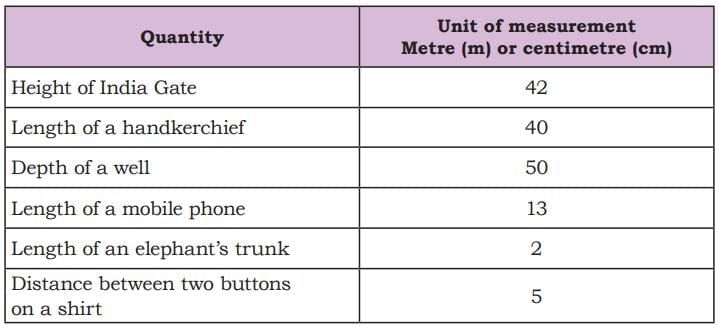
Ans: 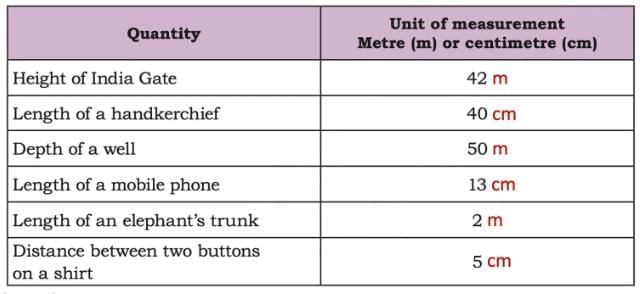
Different Units but Same Measure
Q. Shikha and Sonu are measuring the lengths of saris and stoles in the village weaving centre. Find which measures represent the same sari or stole. You can take help of the double number line below.
Ans:
Page 58
Q. 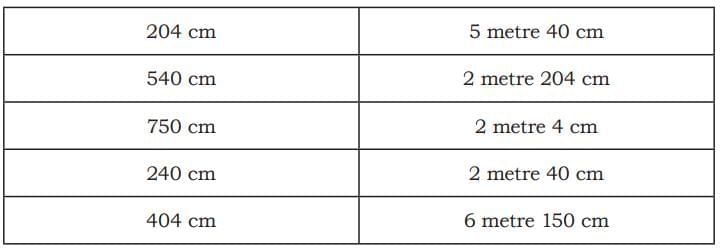 Ans: (i) 204 cm = 200 cm + 4 cm = 2 m + 4 cm = 2m 4 cm.
Ans: (i) 204 cm = 200 cm + 4 cm = 2 m + 4 cm = 2m 4 cm.
(ii) 540 cm = 500 cm + 40 cm = 5 m + 40 cm = 5m 40 cm.
(iii) 750 cm = 600 cm + 150 cm = 6 m + 150 cm = 6 m 150 cm.
(iv) 240 cm = 200 cm + 40 cm = 2 m + 40 cm = 2 m 40 cm.
(v) 404 cm = 200 cm + 204 cm = 2 m + 204 cm = 2m 204 cm.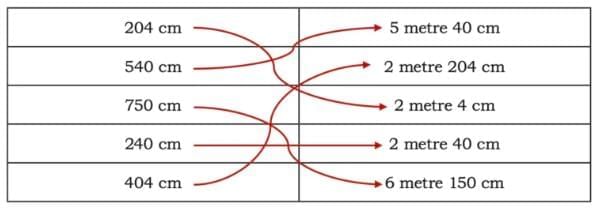
Let Us Compare
Q1. Ritika is comparing the lengths of different rods. Compare them using <, =, > signs.
(a) 456 cm ____ 5 m
(b) 55 cm + 200 cm ____ 200 cm + 54 cm
(c) 6 m 5 cm ___ 6 m 50 cm
(d) 2 m 150 cm ___ 3 m 50 cm
(e) 238 cm ____ 138 cm + 1 m
Ans:
(a) 456 cm ____ 5 m
456 cm ____ 5 × 100 cm
456 cm ____ 500 cm
456 cm < 500 cm
So, 456 cm < 5 m
(b) 55 cm + 200 cm ____ 200 cm + 54 cm
255 cm ____ 254 cm
255 cm > 254 cm
So, 55 cm + 200 cm > 200 cm + 54 cm.
(c) 6 m 5 cm ____ 6 m 50 cm
6 × 100 cm + 5 cm ____ 6 × 100 cm + 50 cm
600 cm + 5 cm ____ 600 cm + 50 cm
605 cm ____ 650 cm
605 cm < 650 cm
∴ 6 m 5 cm < 6 m 50 cm.
(d) 2 m 150 cm ____ 3 m 50 cm
2 × 100 cm + 150 cm ____ 3 × 100 cm + 50 cm
200 cm + 150 cm ____ 300 cm + 50 cm
350 cm = 350 cm
So, 2 m 150 cm = 3 m 50 cm
(e) 238 cm ____ 138 cm + 1 m
238 cm ____ 138 cm + 100 cm
238 cm ____ 238 cm
238 cm = 238 cm
So, 238 cm = 138 cm 1 m.
Q2. World’s tallest statue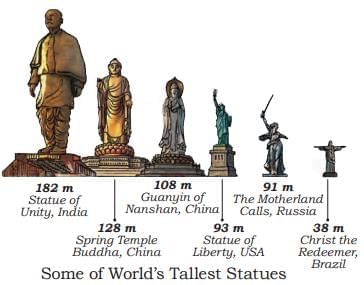
(a) What is the difference between the height of the tallest statue in the world and the Statue of Liberty?
Ans: Height of the tallest statue (Statue of Unity) = 182 m
Height of Statue of Liberty = 93 m
So, difference of their height
= 182 m – 93 m
= 89 m
(b) Identify the statues whose heights have the least difference.
Ans: The heights of the Statue of Liberty (93 m) and the Motherland Calls (91 m) have the least difference. 93 m – 91 m = 2 m.
(c) Identify the statues whose heights have the largest difference.
Ans: The heights of the Statue of Unity (182 m) and Christ the Redeemer (38 m) have the largest difference: 182 − 38 = 144 m.
(d) The height of which statue will be equal to the height of the Statue of Unity, if it is doubled?
Ans: The height of the Motherland Calls = 91 m.
If its height is doubled, 2 × 91 =182 m.
which is equal to the height of the Statue of Unity (182 m).
So, the height of the Motherland Calls, when doubled, will be equal to the height of the Statue of Unity.
Page 59
Let Us Do
Q. Measure 100 m and 200 m on your school playground, or any other place in and around your school, using a Long Tape. Mark these points and draw a straight line. Walk on the lines and count the number of steps. Use this relationship between the number of steps taken and distance walked to find distances around you for at least 3 locations. Wherever possible, walk and find the number of steps. Otherwise, find the distance and estimate the number of steps.
(a) Identify and write the locations that are the nearest and the farthest from your home.
Nearest location __________________________________.
Farthest location __________________________________.
(b) Write the distances obtained above in increasing order. ______, ______, ______, ______.
(c) Name a location that is equal to or more than 1,000 m from your home.
Ans: 100 m took 155 steps.
200 m took 310 steps.
Step length (L) = 100/155 = 0.645 m/step.
Distances for locations:
(i) Home → Corner shop: walked 280 steps
Distance = 280 × 0.645 =180.6 m.
(ii) Home → Park bench: walked 430 steps
Distance =430 × 0.645 = 277.35 m.
(iii) Home → School gate: walked 1200 steps
Distance =1200 × 0.645 =774 m.
(iv) Home → Bus stop: known distance 1.3 km = 1300 m
Steps =1300/0.645 = 2016 steps.
(a) Nearest location: Corner shop (180.6 m).
Farthest location: Bus stop (1.3 km).
(b) Distances in increasing order:
180.6 m < 277.35 m <774 m < 1300 m.
A location equal to or more than 1,000 m from your home: Bus stop (1.3 km).
Let Us Explore
When we walk 1,000 m, we say we have walked 1 km. 1,000 m = 1 km. Kilo stands for thousand. This unit is used to measure long distances.
Q.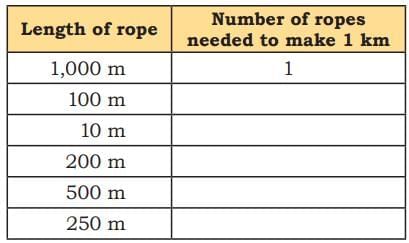 Ans:
Ans: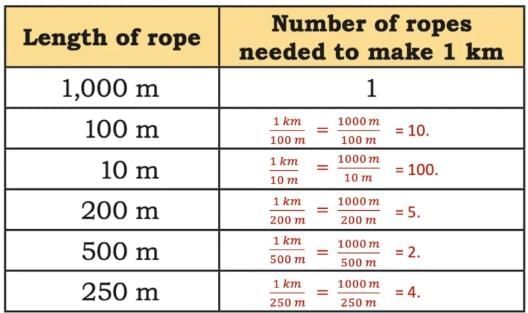
Page 60
Kilometre Race
Sheena and Jennifer are helping to organise a 3-km race. Help them with the arrangements for the race.
Q1. Water stations are to be arranged after every 500 m. How many water stations must be set up? At what positions from the starting point will these water stations be placed?
Ans: Water stations every 500 m.
3000 ÷ 500 = 6.
So, 6 water stations.
Positions from the start: 500 m, 1000 m, 1500 m, 2000 m, 2500 m, 3000 m.
Q2. Children need to stand at an interval of 300 m to direct the runners. How many children are needed? At what positions from the starting point will the children be standing?
Ans: Children standing at intervals of 300 m.
3000 ÷ 300 = 10.
So, 10 children are needed.
Positions from the start: 300 m, 600 m, 900 m, 1200 m, 1500 m, 1800 m, 2100 m, 2400 m, 2700 m, 3000 m.
Q3. Red and blue flags are to be placed alternately at every 50 m. How many red and blue flags are needed till the finish line?
Ans: Red and blue flags alternate every 50 m.
3000 ÷ 50 = 60.
If the flags alternate, the 60 flags are split evenly, with 30 red flags and 30 blue flags.
Let Us Do
Longest Train Journey
Q. The longest train journey in India is by The Vivek Express, which runs from Dibrugarh in Assam to Kanyakumari in Tamil Nadu. Look at the stations on the route shown in the table below and answer the questions.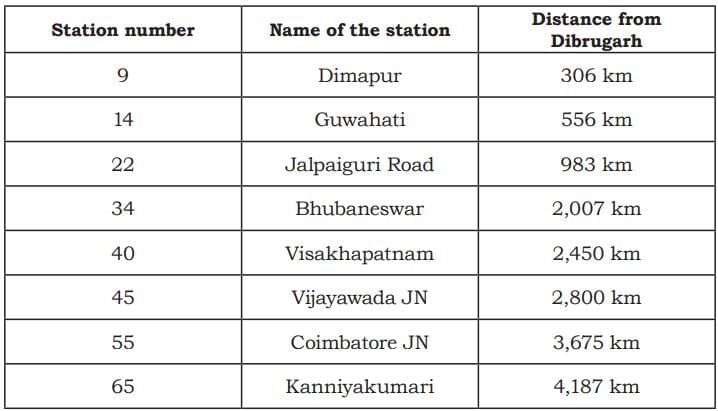
Q1. The total length of the route from Dibrugarh to Kanniyakumari is _______________ km.
Ans: Total length of the route from Dibrugarh to Kanniyakumari = 4187 km.
Q2. The distance between Vijayawada and Jalpaiguri road is _______________.
Ans: The distance between Vijayawada and Jalpaiguri Road = 2800 − 983 = 1817 km.
Q3. Distance between Vijayawada and Visakhapatnam is _______________.
Ans: The distance between Vijayawada and Visakhapatnam = 2800 − 2450 = 350 km.
Q4. Which two stations are farther apart—Guwahati and Dimapur or Bhubaneswar and Jalpaiguri Road?
Ans: Distance between Guwahati and Dimapur = 556 m – 306 km = 250 km.
Distance between Bhubaneswar and Jalpaiguri = 2007 km – 983 km = 1024 km.
Therefore, Bhubaneswar and Jalpaiguri Road are farther apart the Guwahati and Dimapuri.
Q5. What is the distance between Guwahati and Coimbatore JN?
Ans: The distance between Guwahati and Coimbatore JN = 3675 − 556 = 3119 km.
Page 61
Let Us Measure
Q. Measure the lines in the design and write their measurements in cm and mm.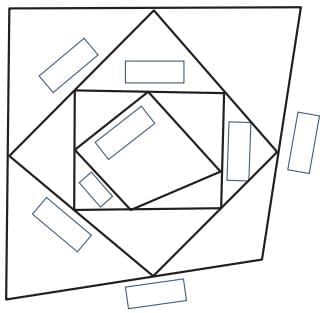 Ans: Find the measurements with the help of a scale.
Ans: Find the measurements with the help of a scale.
Page 62
Let Us Do
Soak some seeds of whole moong or black or white chana overnight. Next morning, take them out and wrap them in a moist cloth to sprout them. Over the next 4 days, take out one seed each day and measure the length of sprout. For ease of measurement, you can either place the seed on a paper and mark the length of the sprout, or use a thread to find its length. Ans:
Ans: By Day 4, sprouts usually grow around 2–3 cm (20–30 mm) in length.
By Day 4, sprouts usually grow around 2–3 cm (20–30 mm) in length.
Let Us Draw
Q. Draw lines of the following lengths in your notebook using a scale.
1. 5 cm 5 mm
2. 3 cm 6 mm
3. 8 cm 3 mm
4. 36 mm
5. 67 mm
How did you draw lines of lengths 36 mm and 67 mm? Share your thoughts in class.
Ans: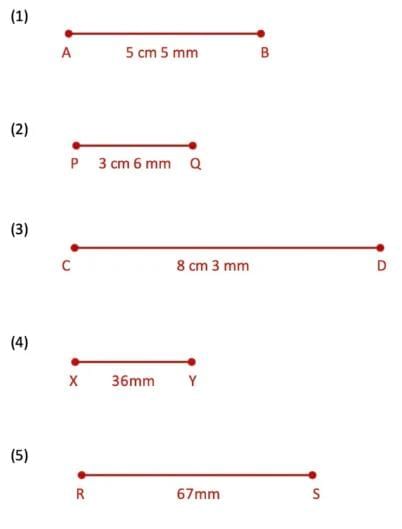
To draw a line of 36 mm and 76 mm:
1. Convert the measurements:
- 36 mm is the same as 3 cm 6 mm (because 10 mm = 1 cm).
- 76 mm is the same as 7 cm 6 mm.
2. Drawing 36 mm:
- Place the scale on the paper, starting at 0.
- Count 3 cm and then 6 small divisions (for the 6 mm) on the scale.
- Mark the point at 36 mm.
3. Draw the line:
Draw a straight line from the starting point to the marked point.
4. Repeat for 76 mm:
Follow the same method to draw the line for 76 mm.
Page 63
Let Us Do
Q1. Fill in the blanks appropriately in the double number lines given below.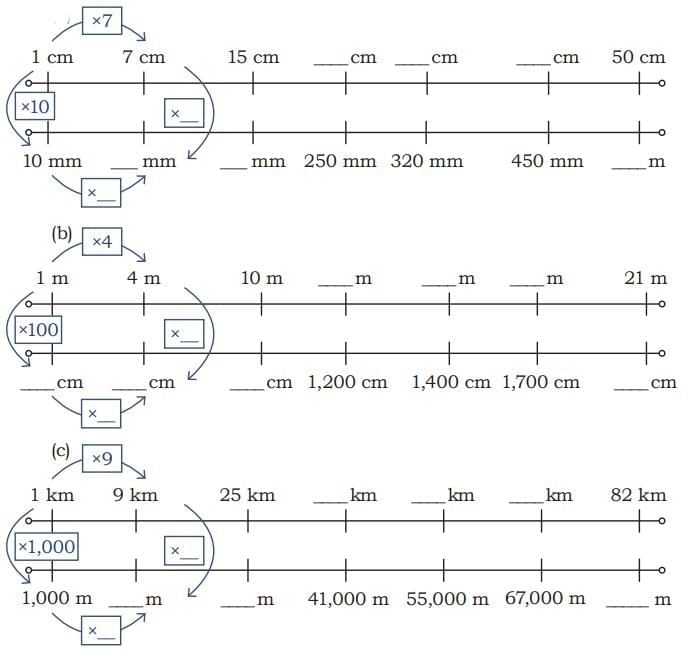 Ans:
Ans: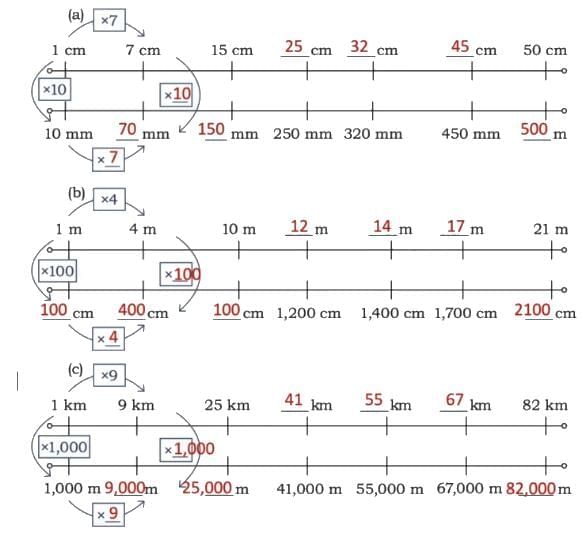
Q2. Use your understanding from above to fill in the blanks appropriately. 

Ans:
(a) 4 cm 5 mm = ______ mm
4 cm 5 mm
= 4 × 10 mm + 5 mm
= 40 mm + 5 mm = 45 mm.
(b) 89 mm = ____ cm ____ mm
89 mm = 80 mm + 9 mm
= 8 cm 9 mm
(c) 234 cm = ______ mm
234 cm = 234 × 10 mm
= 2340 mm.
(d) 514 mm = ______ cm ______ mm
514 mm = 510 mm + 4 mm
= 51 cm 4 mm
(e) 6 m 34 cm = ______ cm
6 m 34 cm = 6 × 100 cm + 34 cm
= 600 cm + 34 cm = 634 cm.
(f) 20 m 12 cm = ______ cm
20 m 12 cm = 20 × 100 cm + 12 cm
= 2000 cm + 12 cm
= 2012 cm.
(g) 397 m = _______ cm
397 m = 397 × 100 cm
= 39,700 cm.
(h) 5,792 cm = ______m ______ cm
Solution:
5792 cm = 5700 cm + 92 cm
= 57 m 92 cm
(i) 9,108 cm = ______ m ______ cm
9,108 cm = 9100 cm + 8 cm
= 91 m 8 cm.
(j) 34 km = _______ m
34 km = 34 × 1000 m
= 34,000 m.
(k) 6,870 m = ______ km ______ m
6,870 m = 6000 m + 870 m
= 6 km 870 m.
(l) 10,552 m = ______ km _____ m
10,552 m = 10,000 m + 552 m
= 10 km 552 m.
(m) 29 km 30 m = ______ m
29 km 30 m = 29 × 1000 m + 30 m
= 29,000 m + 30 m
= 29,030 m.
(n) 32 km 359 m = ______ m
32 km 359 m = 32 × 1000 m + 359 m
= 32,000 m + 359 m
= 32,359 m.
Page 66
Let Us Do
Q1. Rani has two red-coloured ribbon rolls, one of length 3 m 75 cm and another 2 m 25 cm long. How much ribbon does she have?
Ans: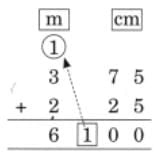
So, Rani has 6 m long ribbon.
Q2. The distance from Bhopal to Sanchi is 48 km 700 m. Bhadbhada Ghat waterfall is on the way, and 17 km 900 m away from Bhopal. How far is Sanchi from the waterfall?
Ans: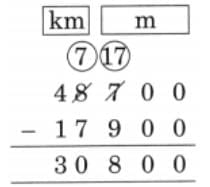
Distance between Bhopal to Sanchi = 48 km 700 m
Distance between Bhopal to Bhadbhada Ghat waterfall = 17 km 900 m.
So, distance between Sanchi and waterfall = 48 km 700 m
= 30 km 800 m
Q3. Gulmarg Gondola in Gulmarg, Kashmir is the second longest and second highest cable car in the world. It is divided into two sections. The first section covers 2 km 300 m and the second section covers 2 km 650 m. What is the total distance covered by the cable car?
Ans: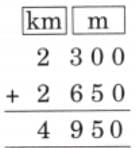
Distance covered by cable car in first section 2 km 300 m.
And distance covered by cable car in second section = 2 m 650 m
Total distance covered by the cable car in these two sections = 2 km 300 m + 2 km 650 m
= 4 km 950 m
Q4. Circle the bigger length and find the difference.
(a) 11 mm and 1 cm
Difference— ________________
(b) 26 mm and 2 cm
Difference— ________________
(c) 20 cm and 201 mm
Difference— ________________
(d) 1,020 mm and 1m
Difference— ________________
(e) 2 m and 245 cm
Difference— ________________
(f) 5,678 m and 6 km
Difference— ________________
(g) 6 km 1,480m and 7 km 479m
Difference— ________________
Ans:
(a) 1 cm = 1 × 10 mm = 10 mm 11 mm > 10 mm So, 11 mm > 1 cm
Difference = 11 mm – 10 mm = 1 mm
(b) 2 cm = 20 mm 26 mm > 20 mm Difference – 26 mm – 2 cm
= 26 mm – 20 mm = 6 mm
(c) 20 cm = 200 mm 200 mm < 201 mm So, 200 mm < 201 mm
Difference = 201 mm – 200 mm = 1 mm
(d) 1 m = 100 cm = 1000 mm 1020 mm > 1000 mm
Difference = 1020 mm -1000 mm = 20 mm
(e) 2 m = 200 cm
200 cm < 245 cm
So, 2 m < 245 cm
Difference = 245 cm – 200 cm = 45 cm
(f) 6 km = 6 × 1000 m = 6000 m
5678 m < 6000 m
Difference = 6000 m 5678 m = 322 m
(g) 6 km 1480 m = 6000 m + 1480 m
= 7480 m 7 km 479 m
= 7000 m + 479 m
= 7479 m
So,7480 m > 7479 m
So, 6 km 1480 > 7 km 479 m
So, difference = 7480 m – 7479 m = 1 m
Multiplying and Dividing Lengths
Q1. We need a 1 m 80 cm cloth to make a shirt for a 10-year old child. How much cloth will be needed to make shirts for 20 such children?
Ans: 20 × 1 m 80 cm = 20 × 1 m and 20 × 80 cm
= 20 m + 1600 cm (Break the quantity into m and cm and multiply. You can also convert it into cm and multiply
= 20 m + 16 m
= 36 m.
Q2. A shop sells cloth for making bags at ₹ 100 for 5 m. How much money is needed to buy a 1 m cloth?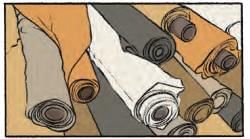
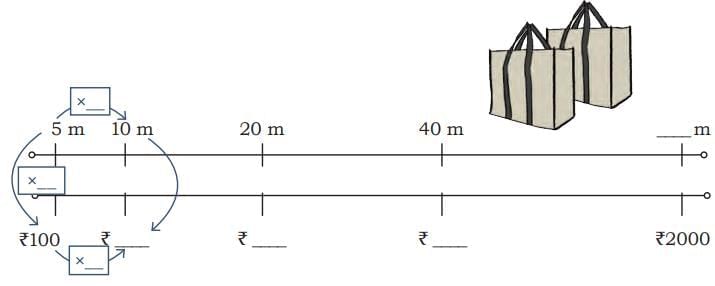 If 5 m cloth costs ₹ 100, then a 1 m cloth costs 100 ÷ 5 = ₹ 20.
If 5 m cloth costs ₹ 100, then a 1 m cloth costs 100 ÷ 5 = ₹ 20.
Now, use the double number line to find the cost of the cloth or the length of cloth that we can buy at a particular cost.
Ans: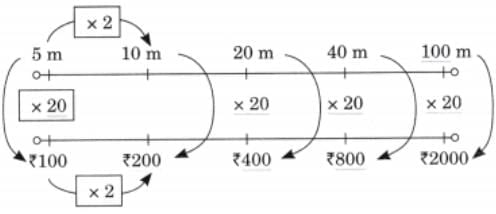
Q3. Anita is making an embroidery on the border of a sari. She needs aim long thread to embroider a 50 cm sari. How much thread would she need for a 5 m sari border? A 1 m long thread costs 50. How much money will be needed to buy the thread?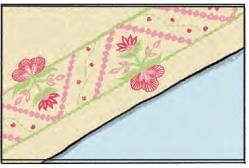 Ans: Length of Sari = 5 m = 500 cm
Ans: Length of Sari = 5 m = 500 cm
Length of Sari that requires 1 mof thread = 50 cm
Number of 50 cm in 500 cm = 500 + 50 = 10
So, Anita needs 10 m of thread.
Cost of 1 m thread = ₹ 50
So, cost of 10 m thread = ₹ 50 × 10 = ₹ 500
Thus, Anita needs 10 meters of thread and the cost will be ₹ 500.
Q4. A road 12 km 600 m long is being laid in a town. The workers lay an equal length of road each day, and complete the work in 6 days. How much road-laying work is done on each day?
Ans: Total length of road = 12 km 600 m
= 12,600 m
Total number of days to complete the work
= 6 days
So, the workers lay 12,600 m ÷ 6 = 2,100 m or 2 km 100 m of road each day.
Page 68
Let Us Estimate
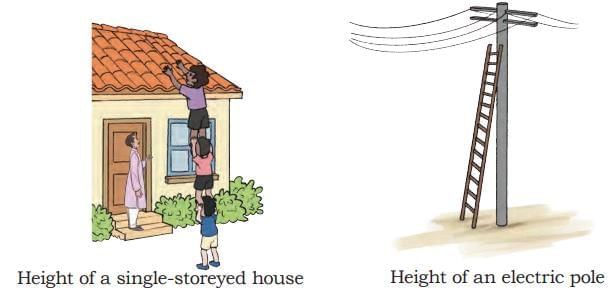
Estimate the following. Share your reasoning in class.
1. The height of the tallest building in your neighbourhood. What did you use as a reference to estimate the height?
2. The height of the tallest tree in your neighbourhood. What did you use as a reference?
3. The depth of a well or swimming pool in your neighbourhood. How did you find out?
Ans:
1. Estimate: I would estimate the height of the tallest building in my neighbourhood by comparing it to something I know is a specific height, like a telephone pole or a streetlight.
Reference: I could use a telephone pole (usually around 10-12 meters tall) to count how many poles fit into the building. For example, if the building looks like it’s 8 telephone poles tall, then I would estimate the building’s height to be about 80-96 meters (8 poles × 10-12 meters each).
2. Estimate: To estimate the height of the tallest tree, I would compare it to a telephone pole or a building that I know the height of.
Reference: If the tree is about as tall as a building I know is around 20 meters, I would estimate that the tree is around 20 meters tall.
3. Estimate: For the well or swimming pool, I would use a ruler or a measuring tape to measure the depth directly if it's safe to do so. If I can’t measure it directly, I would estimate based on how deep it looks compared to something familiar, like the height of a person or the length of a small ladder.
Reference: If the well looks about 10 times as deep as a 2-meter-long ladder, then I would estimate the depth to be about 20 meters.
Let Us Explore
In daily life, we use other units of measuring length as well. Height is usually measured in feet and inches. Look at your ruler to see if inches are also marked on it. Find out how many cm and mm equal 1 inch.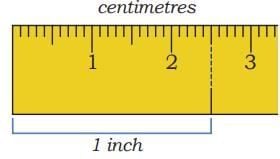
1 inch = 2 cm 5 mm
1 foot = 12 inches or 30 cm.
Ans: Do it yourself.
Page 69
Measure Your Height
Stand against a wall and mark your height. Measure the distance between the floor and the marked point in feet and inches. Similarly, other students in the class can also measure their heights. Find out who is the tallest student in your class. What is his or her height in feet and inches?
Ans: Do it yourself.
|
35 videos|322 docs|7 tests
|
FAQs on Far and Near NCERT Solutions - Mathematics (Maths Mela) Class 5 - New NCERT
| 1. What are the main concepts covered in the chapter "Far and Near"? |  |
| 2. How does the chapter explain the importance of understanding distance? |  |
| 3. What activities or examples are provided to illustrate the concepts of far and near? |  |
| 4. How can teachers engage students in learning about the concepts of far and near? |  |
| 5. Why is it important for students to learn about the concepts of far and near at a young age? |  |
















